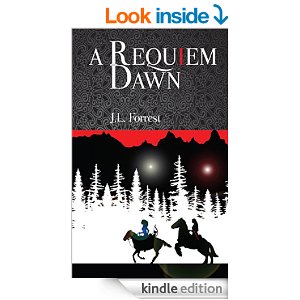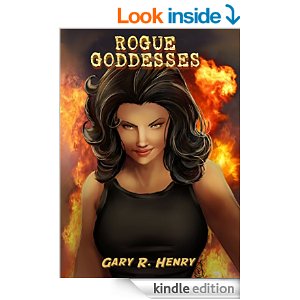Let me begin by saying that writing a novel is a terrific achievement. I know, having written two. My hat is off to anyone who can complete a novel.
That said, here is my honest opinion of A Requiem Dawn, a post-apocalyptic sci fi fantasy by J.L. Forrest.
Characters: A Requiem Dawn‘s characters are detailed and varied, from our heroine Nyahri and the superhuman high-tech alien female she comes to love and serve, Sultah yw Sabi, to sentient insectoid life forms hosted by human and animal bodies, and a terrifying technological demon made of nano-particles.
As a chieftain’s daughter, Nyahri is no princess, or maid to be wooed, but a warrior, huntress and horse-rider. She’s in line of succession to lead her tribe, which appears modeled on 18th and early 19th century native American culture — Arapahoe, I’m guessing — though the story takes place in the far future, centuries after a global cataclysm known as “Eventide.” It’s a world in which humanity and nature have only just begun to reassert themselves.
In Nyahri, through action, dialogue and description, J.L. pens a clear portrait of a superb young woman, dark-haired, freckled, with cinammon skin, who loves and is loved, but will not be owned or reined in — at least not until she meets yw Sabi:
A woman stood before her.
A devil! Nyahri thought.
The devil stood a hand taller than the tallest E’cwn men, her hair blacker than the darkest E’cwn hair. Her opalescent skin glinted. She appeared human but for her coloring, for the long litheness of her arms and legs, for her slender fingers…
“Help me!” the devil growled, grabbing Nyahri’s wrist, the Atreiani’s skin as smooth as sun-warmed, polished stone.
Her hair drank the sunrays, no light reflecting from it. For a moment Nyahri looked into the devil’s eyes— coal irises on black pupils, depthless but for a grieving flood of panic.
A viper’s eyes, Nyahri thought.
J.L. lovingly details every character in the book, from protagonist down to the smallest supernumerary.
Plot: An alien demi-goddess awakes after a global cataclysm 50 centuries before. With Nyahri, who grows to be acolyte and lover, she determines to destroy the rest of her hibernating kind, before they too can wake and re-enslave mankind. But along the way, the pair must help each other survive the frightful perils of a primeval world, and the malignant vestiges of an alien technology.
Setting: The names have changed, but the locations appear to be what was once North America. On their quest to destroy alien citadels where the Atreiani slumber, the pair traverse geography that sounds like the Great Plains and Rocky Mountains. Here, they’re escorted by tribesmen from the wooded foothills.
Throughout the day they kept a brisk pace. The trees opened onto the high meadows, and the company broke from the cedars into the open valleys, veering westward on a deep-trodden path.
A path of generations, Nyahri thought, surely the same my father took in his boyhood.
Dhaos knew the high trails, keeping the travelers clear of mires. During the early afternoon they crested a saddle pass which dropped into wildflower meadows. The troop paused, eating and gazing at the gelid peaks, now closer and larger and crisper. Snow plumes whisked from the pinnacles. As Nyahri marveled at the view, Dhaos sat on his heels beside her.
“There is an alpine pass,” he said, pointing, “between those mountains, quite high. We will cross it before the heaviest snows come, or not at all till spring.”
“I have never seen anything like this, never been so much in the sky. It is hard to breathe.”
Settings are one of the stars of this novel, every bit as vivid as the characters, but integrated into the narrative, so as to be contribution and not distraction.
What I thought could’ve been done better: I got nothing here. I think J.L. is a better writer than I am a critic. A Requiem Dawn appears professionally edited; has full, colorful character and setting descriptions; uses active voice and vivid verbs. The novel covers everything on my checklist, and then some.
I just have two minor points. These aren’t even criticisms, just two things I, personally, think might’ve been kind of neat. First, J.L. has evolved an amazing fantasy vocabulary used throughout the book. In a note at the book’s conclusion, he explains the pronunciations — for instance, “Sultah yw Sabi is pronounced Sŭ• ltă ū Să• bē. (Yw combines from ē and oo and shortens merely to ū.)”
I wish J.L. had put a word about this note in the book’s beginning — I would’ve enjoyed the language aspect even more, had I known there was a guide I could consult throughout.
The next one is tougher — I wish there had been a map showing Nyahri’s (pronounced Nī• ăr• ē, btw) world, superimposed over the outlines of North America, as we know it today. The map could trace the journey, and show the major landmarks of the story and the times. Not exactly a writing-thing I know, but would’ve been fun.
What I thought was good: Everything. Dialogue, description, imagination, action — in my opinion, this is a masterful work, as good or better than anything published by the major houses. The narrative is powerful and riveting, but also written with a kind lyrical quality.
Here, yw Sabi uses some sort of alien sonic technology to destroy a band of C’naädii marauders who ambush the Oudwnii tribesmen guiding her and Nyahri through the snowy mountains:
Four more men surrounded Nyahri, one leveling his axe and shouting, berserk and furious. He swung the weapon over his head, stepping forward to drive it through her. She sidestepped but the haft struck her arm, even as she rolled forward and buried her knife in his thigh.
Nyahri cried out.
Three men remained, moving to finish her.
Sound! Furious sound, as at Abswyn but far worse. Deep like mountains’ roots! High like heaven’s ceiling! Like a river-flood it crashed over Nyahri, chaining her intestines, coiling within her lungs. She lay like a straw doll, her eyes wide, her limbs like sand. All the C’naädii dropped like brained cattle. The Oudwnii fell like sacks.
No one fought anymore. No one ran.
In all this forest, Nyahri thought, nothing moves save the breeze and the horses.
Unable to budge, she wondered for a moment if she’d died. But snow chilled her skin and crows called among the trees. The axe-wielder fell against her side, her longknife hilt still in her bloodied hand. The horses stood unaffected, swishing their tails.
Slow footfalls approached through the snow. Sultah yw Sabi slipped the longknife from Nyahri’s hand, pulling it from the man’s leg. Blood darkened the ice, steaming where it spread into the cold white powder. Nyahri felt her limp body hoisted, the Atreiani’s arms beneath her. Yw Sabi carried her clear of battleground, setting her gently against one of the shelters. Then she knelt, caressing Nyahri’s cheek, looking into her eyes.
“Let yourself go,” yw Sabi said, “don’t fight it, lovely one. The scepter cannot kill unless I beat someone over the head with it. Relax. Let the waves take you and the pain will go.”
Yw Sabi kissed Nyahri’s brow. She held the gore-plastered blade in one hand and the scepter in the other, distorted symbols scoring its surface and witch-fire pulsing from it, like heat rising from a metalsmith’s furnace.
Then yw Sabi walked away from her. Obeying, Nyahri abandoned the struggle to regain her body and an intoxicating warmth washed over her. Nyahri wanted to cry, though even her tear ducts refused to work.
Yw Sabi walked to the first C’naädi in her path. She grabbed a fistful of his hair, lifted him like a bag of feathers, and cut his throat from his windpipe to his spine. His heart, still beating, sprayed the snow with blood. She walked to the next man and did the same, and Nyahri knew: Each man is as I am, each can feel, each knows what is coming.
She watched the Atreiani’s face, watched her calmly go about her work as if threshing grain or shearing sheep. She slaughtered the next man and the next. Yw Sabi raised a naked-faced boy from the snow, no more than twelve, his rusty longknife useless. Yw Sabi slit his throat, frowning and watching his life ebb, and then she dropped him.
One by one she slaughtered every C’naädi. The Atreiani spared none.
Nyahri listened to the blood-wet spatters, the gurgling, one after the other. She wanted to scream.
Apologies for the lengthy excerpt, but I think it’s just so good. This one passage has both gentleness and violence, poetic sensibility and brutal prose. It has high-tech and primitive weaponry. There’s battle and there’s slaughter. They create a unity of opposites, that in my mind, verges on the sublime.
And it is easily representative of the rest of the novel.
Overall: The book shouldn’t really be reviewed at Honest Indie. It should be in the New York Times or Washington Post, or at least in Fantasy and Science Fiction. The fact that it is small press — Robot Cowgirl Press — only goes to show what gems there are to be found in the indie and small press community. A Requiem Dawn is a compelling adventure, written with elegance, power, imagination, passion and compassion. In my opinion, a true virtuoso performance.
Good job, J.L.!
Coming up
Guardians of Terath: Seeking Sorrow by Zen DiPietro
Verliege by Micheal Rivers
Time of Death by Ellis Vidler
The Permeable Web of Time by Martha Fawcett
And for sexy superheroine paranormal sci fi romantic adventure thrillers, check out my own novel American Goddesses on Amazon or Smashwords, and the newly published sequel Rogue Goddesses ~ thanks for visiting Honest Indie!




Just finished Rogue Goddesses. Excellent sequel, and nicely written too. Any plans for a third story with Melnikova? She should get to win someday, and get even more powerful!